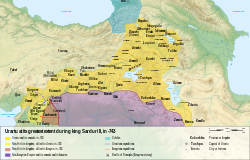
Back Urartu Afrikaans ኡራርቱ Amharic أورارتو Arabic Urartu AST Urartu AVK Urartu Azerbaijani اورارتو AZB Урарту Bashkir Урарту Byelorussian Урарту BE-X-OLD
| 860 BC – 590 BC/547 BC[1] | |||||||||||||
 Urartu under Sarduri II, 743 BC | |||||||||||||
| Capital | |||||||||||||
| Common languages | |||||||||||||
| Religion | Urartian polytheism[4] | ||||||||||||
| Government | Monarchy | ||||||||||||
• 858–844 | Arame | ||||||||||||
• 844–834(?) | Lutipri(?) | ||||||||||||
• 834–828 | Sarduri I | ||||||||||||
• 828–810 | Ishpuini | ||||||||||||
• 810–785 | Menua | ||||||||||||
• 785–753 | Argishti I | ||||||||||||
• 753–735 | Sarduri II | ||||||||||||
• 735–714 | Rusa I | ||||||||||||
• 714–680 | Argishti II | ||||||||||||
• 680–639 | Rusa II | ||||||||||||
• 639–635 | Sarduri III | ||||||||||||
• 629–590 or 629–615 | Rusa III | ||||||||||||
• 615–595 | Sarduri IV | ||||||||||||
• 590–585 | Rusa IV | ||||||||||||
| Historical era | Iron Age | ||||||||||||
• Established | 860 BC | ||||||||||||
• Median conquest (or Achaemenid conquest in 547[5]) | 590 BC/547 BC[1] | ||||||||||||
| |||||||||||||
| History of Armenia |
|---|
 |
| Timeline • Origins • Etymology |
| History of Turkey |
|---|
 |
| Timeline |
|
|
Urartu[b] was an Iron Age kingdom centered around the Armenian highlands between Lake Van, Lake Urmia, and Lake Sevan. The territory of the ancient kingdom of Urartu extended over the modern frontiers of Turkey, Iran, Iraq, and the Republic of Armenia.[7][8] Its kings left behind cuneiform inscriptions in the Urartian language, a member of the Hurro-Urartian language family.[8]
Urartu extended from the Euphrates in the west 850 km2 to the region west of Ardabil in Iran, and 500 km2 from Lake Çıldır near Ardahan in Turkey to the region of Rawandiz in Iraqi Kurdistan.[7] The kingdom emerged in the mid-9th century BC and dominated the Armenian Highlands in the 8th and 7th centuries BC.[8] Urartu frequently warred with Assyria and became, for a time, the most powerful state in the Near East.[8] Weakened by constant conflict, it was eventually conquered, either by the Iranian Medes in the early 6th century BC or by Cyrus the Great in the middle of the 6th century BC.[9][10] Archaeologically, it is noted for its large fortresses and sophisticated metalwork.[8]
Cite error: There are <ref group=lower-alpha> tags or {{efn}} templates on this page, but the references will not show without a {{reflist|group=lower-alpha}} template or {{notelist}} template (see the help page).
- ^ Nunn, Astrid (2011-05-15). "« The Median 'Empire', the End of Urartu and Cyrus the Great's Campaign in 547 BC (Nabonidus Chronicle II 16) ». Ancient West & East 7, 2008, p. 51-66". Abstracta Iranica. Revue bibliographique pour le domaine irano-aryen (in French). 31. doi:10.4000/abstractairanica.39422. ISSN 0240-8910.
Après citation des passages pertinents, analyse des toponymes et une nouvelle lecture de la Chronique de Nabonide II 16, dont le nom géographique clef doit être lu « Urartu », il reste : Cyrus le Grand a « marché vers Urartu et vaincu son roi ». Urartu n'a donc pas été détruit par les Mèdes à la fin du VIIe s. mais a continué à exister comme entité politique jusqu'au milieu du VIe s. La Chronique de Nabonide (II 16) montre bien que la conquête de Cyrus le Grand mit fin à ce royaume.
- ^ Van de Mieroop, Marc (2007). A History of the Ancient Near East, ca. 3000-323 BC. Blackwell Publishing. p. 215.
- ^ Diakonoff, Igor M (1992). "First Evidence of the Proto-Armenian Language in Eastern Anatolia". Annual of Armenian Linguistics. 13: 51–54. ISSN 0271-9800.
- ^ Avia Taffet; Jak Yakar (1998). "Politics and religion in Urartu". In Takahito, Prince Mikasa (ed.). Essays on Ancient Anatolia in the Second Millennium B.C. Bulletin of the Middle Eastern Culture Center in Japan. Vol. 10. Chūkintō-Bunka-Sentā Tōkyō: Harrassowitz Verlag. pp. 133–140. ISBN 978-3-447-03967-3. ISSN 0177-1647.
- ^ Nunn, Astrid (2011-05-15). "« The Median 'Empire', the End of Urartu and Cyrus the Great's Campaign in 547 BC (Nabonidus Chronicle II 16) ». Ancient West & East 7, 2008, p. 51-66". Abstracta Iranica. Revue bibliographique pour le domaine irano-aryen (in French). 31. doi:10.4000/abstractairanica.39422. ISSN 0240-8910.
Après citation des passages pertinents, analyse des toponymes et une nouvelle lecture de la Chronique de Nabonide II 16, dont le nom géographique clef doit être lu « Urartu », il reste : Cyrus le Grand a « marché vers Urartu et vaincu son roi ». Urartu n'a donc pas été détruit par les Mèdes à la fin du VIIe s. mais a continué à exister comme entité politique jusqu'au milieu du VIe s. La Chronique de Nabonide (II 16) montre bien que la conquête de Cyrus le Grand mit fin à ce royaume.
- ^ Eberhard Schrader, The Cuneiform inscriptions and the Old Testament (1885), p. 65.
- ^ a b Kleiss, Wolfram (2008). "URARTU IN IRAN". Encyclopædia Iranica.
- ^ a b c d e Cite error: The named reference
:1was invoked but never defined (see the help page). - ^ Jacobson, Esther (1995). The Art of the Scythians: The Interpenetration of Cultures at the Edge of the Hellenic World. BRILL. p. 33. ISBN 978-90-04-09856-5.
- ^ Cite error: The named reference
:6was invoked but never defined (see the help page).